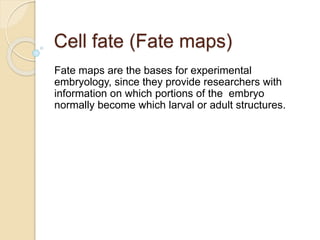
Cell fate (fate maps)
- 1. Cell fate (Fate maps) Fate maps are the bases for experimental embryology, since they provide researchers with information on which portions of the embryo normally become which larval or adult structures.
- 2. By the late 1800s, the cell had been conclusively demonstrated to be the basis for anatomy and physiology. Embryologists, too, began to base their field on the cell. One of the most important programs of descriptive embryology became the tracing of cell lineages: following individual cells to see what they become. In many organisms, this fine a resolution is not possible, but one can label groups of cells to see what that area of the embryo will become. By bringing such studies together, one can construct a fate map. These diagrams "map" the larval or adult structure onto the region of the embryo from which it arose.
- 3. Fate maps of some embryos at the early gastrula stage are shown in Figure 1.6. Fate maps have been generated in several ways
- 4. OBSERVING LIVING EMBRYOS The embryos of certain invertebrates are transparent, have relatively few cells, and the daughter cells remain close to one another. In such cases, it is actually possible to look through the microscope and trace the descendants of a particular cell into the organs they generate. This type of study was performed about a century ago by Edwin G. Conklin. In one of these studies, he took eggs of the tunicate Styela partita, a sea squirt that resides in the waters off the coast of Massachusetts, and patiently followed the fates of every cell in the embryo until each differentiated into particular structures Figure 1 . 7; Conklin 1905).
- 7. He was helped in this endeavor by a peculiarity of the StyeIa egg, wherein the different cells contain different pigments. For example, the muscle-forming cells always had a yellow color. Conklin's fate map was confirmed by cell removal experiments. Removal of the 54.1 cell (which according to the map should produce all the tail musculature), for example, resulted in a larva with no tail muscles (Reverberi and Minganti 1946).
- 8. VITAL DYE MARKING Most embryos are not so accommodating as to have cells of different colors. Nor do all embryos have as few celIs as tunicates. In the early years of the twentieth century, Vogt (1929) traced the fates of different areas of amphibian eggs by applying vital dyes to the region of interest. Vital dyes will stain cells but not kill them. Vogt mixed the dye with agar and spread the agar on a microscope slide to dry. The ends of the dyed agar were very thin. He cut chips from these ends and placed them onto a frog embryo. After the dye stained the cells, the agar chip was removed and cell movements within the embryo could be followed (Figure 1 .8)
- 10. RADIOACTlVE LABEL1NG AND FLUORESCENT DYES � A variant of the dye-marking technique is to make one area of the embryo radioactive. To do this, a donor embryo is usually grown in a solution containing radioactive thymidine. This base becomes incorporated into the DNA of the dividing embryo. A second embryo (the host embryo) is grown under normal conditions. The region of interest is cut out from the host embryo and is replaced by a radioactive graft from the donor
- 11. One of the problems wiith both vital dyes and radioactive labels is that, as they become more diluted with each cell division, they become difficult to detect. One way around this problem is the use of fluorescent dyes that are so intense that Once injected into individual cells, they can still be detected in the progeny of these cells many divisions later. Fluorescein-conjugated dextran, for exampIe, can be injected into a single cell of an early embryo, and the descendants of that cell can be seen by examining the embryo under ultraviolet light (Figure 1 .9). More recently, diI, a powerfully fluorescent molecule that becomes incorporated into lipid membranes, has also been used to follow the fates of cells and their progeny
- 13. GENETIC MARKING One permanent way of marking cells and following their fates is to create "mosaic" embryos in which the same organism contains cells with different genetic constitutions.
- 14. One of the best examples of tl1is technique is the construction of chimeric embryos/ consisting, for example, of a graft of quail cells inside a chick embryo. Chicks and quail develop in a very similar manner (especially during early embryonic development), and the grafted quail cells become integrated into the chick embryo and participate in the construction of the various organs. The substitution of quail cells for chick cells can be performed on an embryo while it is still inside the egg, and the chick that hatches will have quail cells in particular sites, depending upon where the graft was placed.
- 15. Quail cells differ from chick cells in two important ways. First, the quail nucleus has condensed DNA (heterochromatin) concentrated around the nucleoli, making quail nuclei easily distinguishable from chick nuclei. Second, cell-specfic antigens that are quail- specific can be used to find individual quail cells, even if they are "hidden" within a large population of chick cells. In this way, fine-structure maps of the chick brain and skeletal system have been produced (Figure 1.10; Le Douarin 1969; i.e Douarin and Teillet 1973).
- 17. Reference Developmental Biology by Scott F Gilbert and Susan R Singer (Eighth Edition) Page no: 10-13
